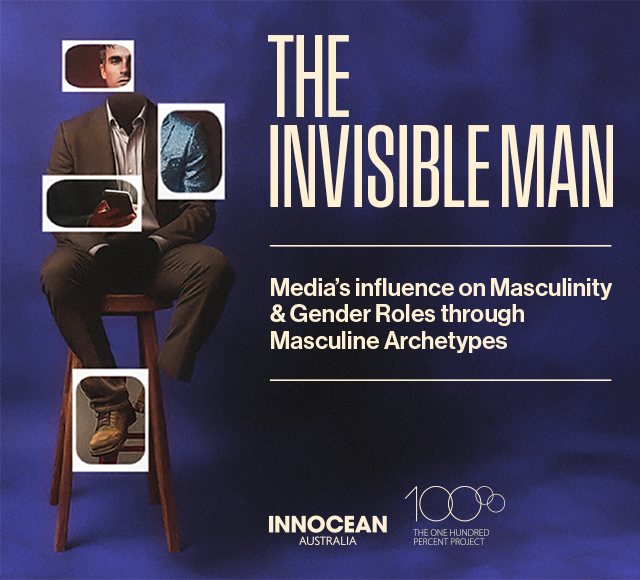Diversity of Thought Blog
The Invisible Man: Rethinking Masculinity to Advance Gender Equity – Dav Lippasaar, Director, The 100% Project

Conversations about gender equity often focus on the structural disadvantages experienced by women, and rightfully so. However, achieving true equality requires us to consider the other half of the equation: men. Understanding how masculinity is shaped, portrayed, and internalised can unlock new pathways for more inclusive societies.
That’s the central premise of The Invisible Man: Masculine Archetypes in the Media (The 100% Project, 2025) — a groundbreaking study that sheds light on how media influences male identity and, in turn, impacts gender equity in Australia. The research offers timely insights into the dominant masculine archetypes men see, how they respond to them, and what that means for future progress.
What Is “The Invisible Man”?
Commissioned by The 100% Project and developed in partnership with INNOCEAN, The Invisible Man research aimed to better understand how media (television, film, and advertising) portray masculinity and how those portrayals influence men’s behaviours, beliefs, and roles in society. The findings were drawn from an online survey of 390 men and in-depth interviews with 11 participants.
At the core of the study is a powerful question: how do masculine archetypes either promote or hinder progress toward gender equity?
Key Findings: The Archetypes and Their Influence
The research revealed that media representations of men tend to fall into a narrow set of archetypes:
- The Hero – Strong, stoic, self-sacrificing
- The Provider – Responsible, hardworking, emotionally restrained
- The Hedonist – Fun-seeking, impulsive, rebellious
These archetypes, while not inherently harmful, contribute to rigid expectations around masculinity. Men who identified strongly with the Hero, Provider or Hedonist were also more likely to endorse benevolent sexism, which includes seemingly “positive” but ultimately patronising attitudes toward women (The 100% Project, 2025).
Perhaps more concerning was the link between media consumption and psychological pressure. Greater media consumption was correlated with increased pressure to conform to these archetypes. Younger men were likelier to relate to the Hedonist, while older men aligned more closely with the Provider. These pressures can become internalised, affecting how men see themselves and their role in society.
The Missing Narratives
One of the most significant takeaways from the study is what’s missing from our screens:
“Men want to see themselves as emotional, honourable, and relatable”
(The 100% Project, 2025).
Participants expressed a desire for media to reflect more emotionally open, diverse, and modern portrayals of men. Interviewees highlighted the importance of normalising male vulnerability, caregiving, and participation in contemporary family life.
When the media fails to represent these traits, it not only limits men’s sense of identity but also stifles progress in achieving gender equity. Men are discouraged from stepping into roles that are essential to equitable outcomes: caregivers, allies, emotionally aware partners, and advocates for change.
These missing narratives also intersect with other identities and lived experiences, including race, sexuality, socioeconomic status, and cultural background. A more intersectional approach to male representation in media can pave the way for inclusive, equitable conversations across the gender spectrum.
Why This Matters for Gender Equity
By reinforcing narrow roles for men, the media indirectly upholds gender inequality. When boys and men are taught that being nurturing, collaborative, or emotionally expressive is “less masculine”, they are less likely to take on roles that support gender-equal environments — in the home, the workplace, or the public sphere.
These limited archetypes also take a toll on men themselves. Suppressing emotional expression and conforming to restrictive ideals is linked to increased rates of isolation, depression, and suicide among men (Beyond Blue, 2021; WHO, 2022).
Further, when men feel unable to participate authentically in conversations about gender, it creates a void often filled by fringe voices. In today’s digital landscape, misinformation about gender roles is usually amplified by the most extreme and polarising opinions. If the moderate, curious, and respectful male voice remains silent, it limits our collective ability to foster shared understanding and progress.
By challenging these norms and embracing new representations of masculinity, we create more psychologically safe environments — for everyone. Normalising emotional expression, active caregiving, and vulnerability in men is not just good for gender equity — it’s good for mental health, workplace well-being, and stronger communities.
A Path Forward: Redefining Masculinity
So, what should the future look like?
Based on interviews with participants, the report outlines five themes for how men would like to be portrayed:
- Complex and Dynamic – Showing a full spectrum of male experience
- Contemporary Family Roles – Men as engaged fathers, partners, and carers
- “Normal” Men – Relatable, imperfect, and emotionally accessible
- Men as Emotional – Open about feelings and mental health
- Honourable and Noble – Values-driven rather than dominance-driven
These portrayals offer a more accurate and inspiring vision of masculinity, allowing men to step into roles supporting their well-being and broader gender equity goals.
What Organisations and Leaders Can Do
The responsibility for reshaping masculinity and advancing gender equity doesn’t sit solely with individuals — it also falls on institutions, workplaces, and leaders to take action. Here’s how:
- Audit your content: Review internal and external communications, training materials, and advertising to identify and challenge limiting male stereotypes.
- Create safe spaces: Encourage open dialogue among men in the workplace and within community settings.
- Champion diverse stories: Elevate narratives that reflect the full diversity of men’s lives, including caregiving, emotional labour, and allyship.
- Invest in education and training: Promote programmes that challenge traditional gender norms and foster inclusive leadership.
- Model the message from the top: When leaders visibly embrace inclusive values and diverse expressions of masculinity, it permits others to do the same.
Conclusion: Let’s Make the Invisible Visible
The Invisible Man reminds us that gender equity isn’t only about correcting the imbalance for women—it also involves reimagining the spaces men can occupy. This reimagining offers a hopeful path towards a more equitable future.
This means expanding the conversation about masculinity, challenging what we see in the media, and giving men permission to show up in all their complexity. By doing so, we don’t just support men’s well-being — we unlock new opportunities for meaningful, lasting gender equity.
Download the full research report here.
Follow The 100% Project on LinkedIn if you’re interested to learn more about our research or reach out to us if you want to get involved or explore partnership opportunities with us.
References
- Beyond Blue. (2021). Men’s mental health: Understanding the risk factors and challenges. Beyond Blue.
- The 100% Project. (2025). The Invisible Man: Masculine Archetypes in the Media. The 100% Project X Innocean.
- World Health Organization (WHO). (2022). Suicide worldwide in 2022: Global health estimates. World Health Organization.

